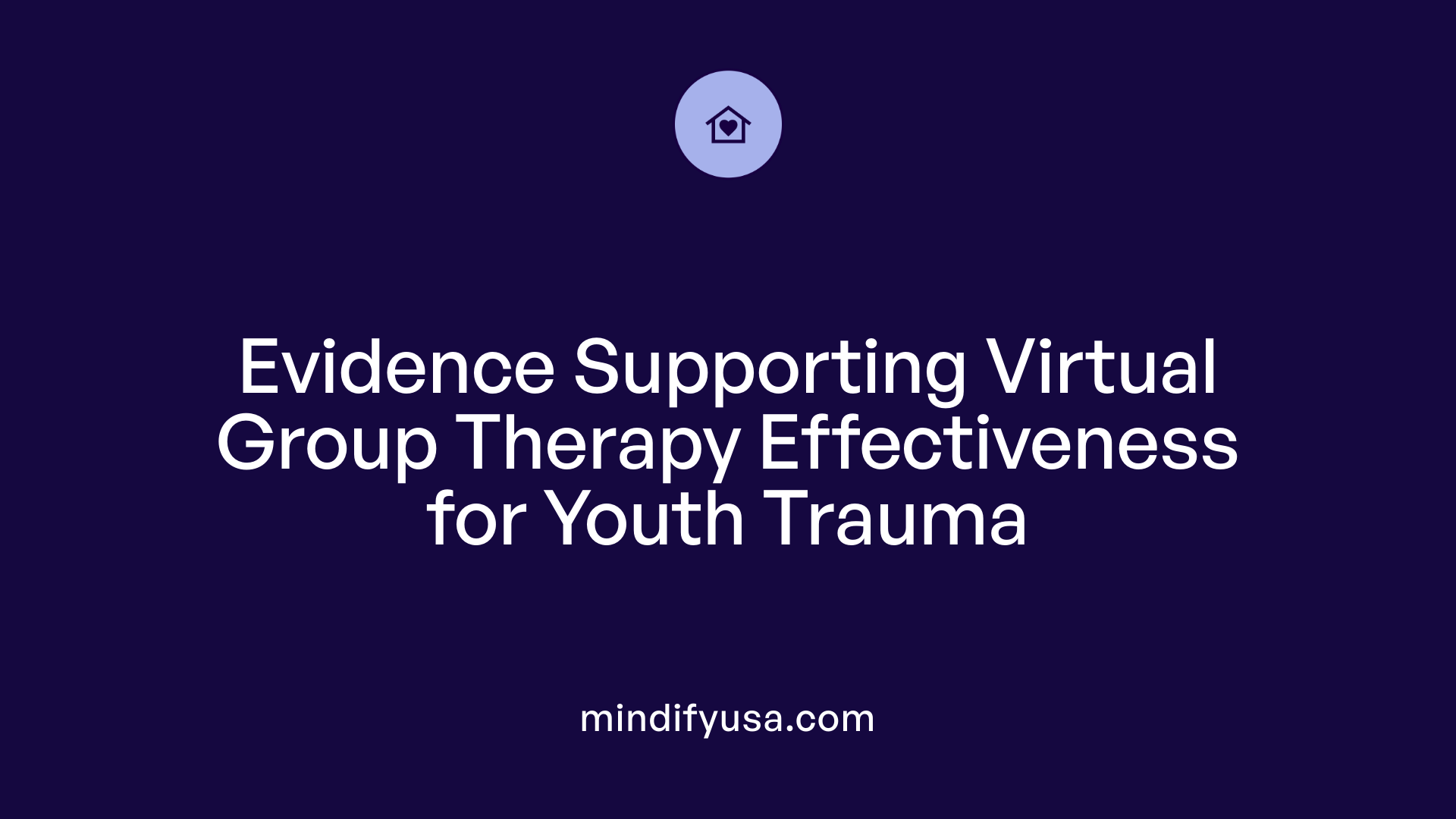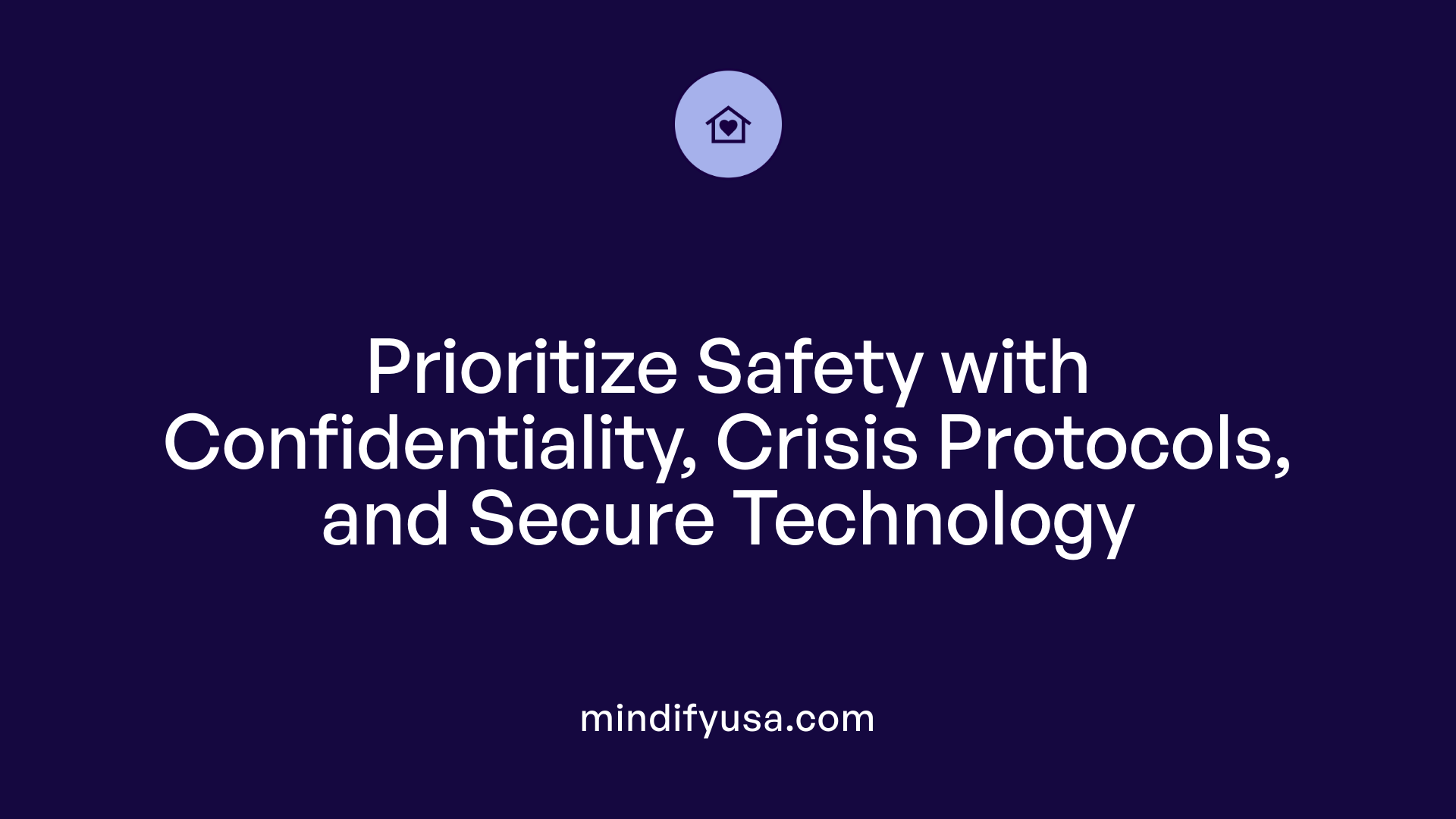Bridging Gaps in Youth Trauma Support Through Digital Platforms
As the demand for accessible mental health interventions grows, virtual group sessions have emerged as a vital resource for supporting traumatized youth. These online formats offer safe, scalable, and evidence-based approaches that reach children and adolescents in diverse environments, including foster, adoptive, and kinship caregiving contexts. This article explores the landscape of virtual youth trauma support, highlighting programs, therapeutic modalities, safety considerations, and innovative digital tools designed to enhance recovery and resilience.
Overview of Virtual Support Resources for Youth Trauma

What resources are available for youth trauma support in virtual settings, including support groups and educational materials?
In recent years, especially amid the COVID-19 pandemic, virtual platforms have become vital for delivering trauma support to youth. Numerous organizations and programs provide online support groups, therapy options, and educational resources tailored to young people's unique needs.
One prominent resource includes virtual support groups facilitated by mental health professionals, targeting both youth and their caregivers. For example, organizations like SHE RECOVERS® offer online, topic-focused groups for women, non-binary individuals, veterans, and caregivers, including trauma-informed yoga, recovery sessions, and community sharing via Zoom and Facebook. Similarly, the Trauma and Healing Program by various health organizations offers virtual therapy and support for children and families, incorporating evidence-based approaches like Trauma-Focused Cognitive Behavioral Therapy (TF-CBT) and EMDR.
Support groups span a wide spectrum of specific needs, such as grief, behavioral challenges, foster care, and adoptive parenting. NAMI's virtual Family Support Groups and peer-led NAMI Connection groups further exemplify accessible community-based support for both youth and families living with mental health conditions.
Beyond support groups, digital trauma support tools are readily available. For example, support apps like the trauma support app for youth aged 14-19, co-designed with young co-researchers, provide psychoeducation, relaxation techniques, mood monitoring, and quick access to resources. These apps focus on engagement through text, audio, and video content, making them accessible and user-friendly.
Telehealth mental health services like Brave Health and online group therapy platforms such as BetterHelp and Talkspace expand access to trauma-focused therapy. These platforms offer evidence-based treatments like CBT, ACT, and somatic therapies, typically led by licensed professionals. They often include features like emotional regulation training, coping strategies, and community sharing, conducive for trauma recovery.
Educational materials and training programs further support trauma-informed care. The Safe Spaces training, offered as a free online module, helps educators and caregivers recognize trauma symptoms and respond effectively. It covers developmental stages and culturally responsive strategies, ensuring a broad, inclusive approach.
Many organizations also provide resources for trauma-informed telehealth practices. These include best practices like involving caregivers to reinforce regulation skills at home through apps, virtual sensory rooms, and mindfulness exercises using digital tools.
In summary, multiple support avenues are available virtually to assist youth dealing with trauma. These range from peer-led and professional support groups, mobile applications, online therapy platforms, to comprehensive training modules for caregivers and educators, all designed to foster healing, resilience, and ongoing support seamlessly accessible from home or community settings.
The Promise of Virtual Group Therapy for Traumatized Youth

What are the benefits and challenges associated with virtual group therapy for traumatized youth?
Virtual group therapy has become a vital resource for supporting young individuals who have experienced trauma. One of its most significant advantages is improved access to mental health services. Children and teens living in rural, remote, or underserved areas often face barriers such as transportation issues, limited local providers, or stigma associated with seeking in-person treatment. Telehealth overcomes some of these obstacles by making therapy sessions reachable from any location with internet access.
Flexibility in scheduling is another key benefit. Virtual therapy allows families to fit sessions into busy routines, reducing logistical stress and increasing the likelihood of consistent participation. This convenience can lead to better engagement and higher treatment adherence.
For many young clients, engaging in therapy from the comfort of their own home creates a less intimidating environment. This setting can facilitate openness, honesty, and a sense of safety, which are crucial when discussing sensitive trauma-related issues. Additionally, clinicians can observe the child’s home environment—providing richer contextual understanding that can enhance tailored interventions.
However, virtual group therapy also comes with notable challenges. Establishing a strong therapeutic rapport can be more difficult through a screen, especially with younger children who may have limited attention spans or difficulty expressing emotions digitally. Building trust often requires additional effort and creative engagement strategies.
Assessing emotional cues is another obstacle. Non-verbal signals—such as body language and subtle facial expressions—are harder to interpret remotely, potentially impacting the therapist’s ability to gauge a child’s immediate reactions or distress levels.
Technological issues frequently hinder sessions. Unstable internet, software glitches, or lack of device access can disrupt continuity of care and frustrate both participants and providers.
Age-related factors also play a role. Younger children may struggle with screens or require more interactive, play-based approaches, which can be limited through virtual formats. Screen fatigue, or digital exhaustion, may cause reduced attention spans and engagement over time.
Furthermore, many clinicians feel there is a gap in specialized training for effective teletherapy, especially in trauma-focused care. Without standardized education and protocols, therapists may find it challenging to adapt certain techniques to the virtual space while ensuring safety, privacy, and confidentiality.
Despite these hurdles, ongoing innovations, provider training, and technological advancements present opportunities to optimize virtual group therapy. As evidence accumulates, it's clear that telehealth can be a powerful component in a comprehensive trauma treatment strategy—if these challenges are thoughtfully addressed.
Best Practices in Conducting Virtual Trauma Support Groups

What are best practices for facilitating virtual trauma support groups for youth and their caregivers?
Running effective virtual trauma support groups requires careful planning and a trauma-sensitive approach. Facilitators should prioritize creating a safe, respectful, and inclusive environment that acknowledges the unique needs of each participant.
A fundamental aspect is ensuring confidentiality. Clear ground rules should be established at the outset, emphasizing respectful communication and privacy to foster trust among group members.
Facilitators need specialized training in online engagement strategies, trauma-informed care, and managing group dynamics. This training equips them to handle challenging situations, such as emotional distress or disruptive behavior, with patience and kindness.
Creating an accessible atmosphere is crucial. This includes selecting user-friendly platforms, providing tech support as needed, and considering participants’ diverse backgrounds and needs.
Regular assessment of the group’s progress informs facilitators about what is working well and what adjustments are necessary. Encouraging participant feedback helps tailor sessions to meet evolving needs.
Flexibility in content delivery allows facilitators to adapt topics based on current group dynamics, emerging themes, or external factors impacting participants.
Organization readiness also plays a role. Establishing partnerships across healthcare, education, and community sectors can enhance resource sharing and sustainability.
Promoting equity in access involves addressing barriers like internet connectivity, device availability, and language differences to ensure all participants can benefit.
In summary, effective virtual trauma support groups depend on skilled facilitation grounded in trauma-informed principles, clear safety protocols, continuous assessment, and adaptive practices.
| Aspect | Description | Practical Tips |
|---|---|---|
| Facilitation | Trauma-informed, sensitive, and skilled leadership | Provide specialized training, maintain a calm demeanor |
| Confidentiality & Safety | Protect participant privacy and emotional safety | Set ground rules, use secure platforms |
| Engagement & Dynamics | Foster active participation and manage group interactions | Use engaging activities, monitor group cohesion |
| Accessibility & Equity | Ensure all can participate meaningfully | Offer tech support, provide materials accessible in multiple languages |
Implementing these practices enhances the therapeutic impact of virtual support groups for youth and caregivers handling trauma, making them safer, more supportive, and more effective in promoting healing.
Efficacy of Virtual Group Interventions for Youth Trauma Recovery

How effective are virtual group therapy programs for traumatized young people?
Research indicates that virtual group therapy programs are significantly effective for young people who have experienced trauma. These interventions often lead to notable reductions in trauma symptoms and also benefit related issues such as anxiety, depression, and social functioning.
Studies examining trauma-focused cognitive behavioral therapy (TF-CBT) delivered via telehealth show outcomes that are comparable to traditional in-person therapy. Many participants report meaningful improvements within just a few months of starting treatment. Meta-analyses of online trauma interventions reveal moderate to large effects, emphasizing their potential to improve mental health in young trauma survivors.
Several programs stand out in demonstrating this efficacy. For example, evidence-informed group treatments like the Trauma and Healing Program, which uses structured trauma therapy techniques, show promising results when delivered virtually. These programs often incorporate evidence-based modalities such as CBT, EMDR, and somatic therapies, tailored for remote delivery.
However, virtual interventions are not without challenges. High attrition rates can occur, especially when engagement drops without the physical presence of a therapist or peer group. Technological barriers, such as lack of reliable internet or devices, can also limit access for some youth. Privacy issues and safety concerns require careful management, particularly when serving vulnerable populations.
Despite these obstacles, the expanding availability of telehealth services, virtual support groups, and app-based therapies offers a way to reach youth who might not otherwise receive help. The COVID-19 pandemic accelerated this shift, demonstrating that, under the right conditions, virtual group therapy can be both accessible and effective for trauma recovery.
Outcome measures used in evaluating virtual trauma interventions
Evaluations of virtual trauma programs use a variety of outcome measures to determine effectiveness. These include standardized symptom scales for trauma, depression, and anxiety, as well as assessments of emotional regulation, social functioning, and overall well-being.
Specific tools such as the Child and Adolescent Trauma Treatment Outcome Scale or post-treatment PTSD checklists are common. Additionally, caregiver reports, self-reports from youth, and clinician observations contribute to a comprehensive view of progress.
More recently, digital tools such as mood monitoring temperate devices or app-based questionnaires assist in tracking symptom fluctuations in real-time. User satisfaction and engagement metrics are also crucial, evaluating usability, perceived helpfulness, and retention rates.
Limitations and considerations
While virtual group therapies offer many benefits, several limitations merit attention. Not all youth have equal access to reliable technology or private spaces for therapy, creating disparities.
Engagement can be more challenging remotely, and some young people may find it harder to form trust or deeply connect via screens. Privacy and confidentiality must be vigilantly protected to prevent breaches during virtual sessions.
Furthermore, the efficacy of virtual trauma interventions depends on careful screening, therapist training in telehealth modalities, and tailored approaches to different developmental stages and cultural backgrounds. Ongoing evaluation, including feedback from youth and caregivers, helps refine these programs.
In conclusion, virtual group therapy presents a promising avenue for youth trauma recovery, supported by solid evidence. As technology improves and practitioners adapt, these interventions are poised to broaden their reach and enhance outcomes for young trauma survivors.
| Program Type | Delivery Mode | Evidence Base | Typical Outcomes | Challenges |
|---|---|---|---|---|
| Trauma-focused CBT | Virtual, group & individual | Strong | Symptom reduction, improved functioning | Engagement, accessibility, privacy |
| Trauma support groups | Telehealth platforms | Moderate | Emotional support, reduced isolation | Attrition, technological barriers |
| App-based interventions | Smartphone, web apps | Emerging | Psychoeducation, emotional regulation | Usability, confidentiality |
This evolving landscape highlights the importance of integrating technology thoughtfully into mental health services for trauma-affected youth, maximizing benefits while addressing challenges.
Evidence-Based Approaches for Delivering Virtual Trauma Support
What are some evidence-based approaches and methods for delivering virtual trauma support to youth?
Delivering trauma support through virtual platforms has become increasingly vital, especially during times of crisis like the COVID-19 pandemic. Several evidence-based methods are utilized to help young people recover from trauma and address related symptoms.
One of the most established approaches is trauma-focused cognitive-behavioral therapy (TF-CBT). This modality has been successfully adapted for internet- and mobile-based interventions. These digital versions typically include psychoeducation, emotion regulation techniques, imaginal exposure, and cognitive restructuring, all guided by trained eCoaches. Such adaptations help make therapy accessible and flexible for young people, reducing barriers related to distance and stigma.
Virtual reality exposure therapy (VRET) is another innovative tool gaining ground. It uses head-mounted displays to simulate trauma-related scenarios, allowing for exposure in a controlled, safe virtual environment. This technique draws on the principles of prolonged exposure therapy and has shown promising results, especially among adult populations. Its application for youth is expanding as technology becomes more affordable and adaptable, offering immersive experiences that facilitate trauma processing.
Telehealth delivery of TF-CBT has demonstrated feasibility in multiple studies, producing significant symptom reductions in participants. For example, online therapy sessions enable children and adolescents to work through traumatic memories with guided support, often resulting in improved emotional and behavioral functioning. However, systemic barriers such as internet access and privacy concerns can affect retention rates and overall success.
Besides individual therapy, psychoeducational group interventions like 'Managing Youth Trauma Effectively' (MYTE) are proving effective. Programs focused on equipping caregivers with trauma-informed parenting strategies can be delivered via telehealth, improving parent-child relationships and reducing child behavioral issues. These approaches not only provide direct support but also foster a supportive community around trauma recovery.
Digital technology enhances trauma treatment by increasing access, reducing stigma, and enabling tailored interventions. Apps, virtual support groups, and online therapy platforms form an essential part of contemporary trauma care, reaching diverse populations regardless of geographical location.
| Approach | Mode of Delivery | Key Features | Evidence & Outcomes |
|---|---|---|---|
| TF-CBT | Online modules, telehealth sessions | Psychoeducation, emotion regulation, imaginal exposure, cognitive restructuring | Significant symptom reduction in children and adolescents |
| VRET | Virtual reality headsets | Immersive exposure to trauma scenarios, safe environment | Promising results especially in adult trauma populations, expanding for youth |
| Psychoeducational Groups | Virtual group sessions | Parenting strategies, trauma education, supportive community | Improved parenting practices, reduced child behavioral problems |
| App-Based Interventions | Mobile apps and online resources | Psychoeducation, relaxation, cognitive techniques | Enhanced engagement, personalized support |
The integration of these approaches---with technology-driven solutions like virtual reality and mobile apps---represents a frontier in effective, accessible trauma care for youth. As research advances, these digital modalities are expected to become even more refined, ensuring trauma support is available to all children and teens, no matter where they live.
Safety Considerations for Virtual Youth Trauma Interventions

What safety considerations should be taken into account when implementing virtual youth trauma interventions?
Implementing trauma-focused support services in a virtual setting requires careful attention to safety and confidentiality. First and foremost, maintaining client privacy involves utilizing secure, encrypted digital platforms that comply with health information privacy standards like HIPAA. This ensures that the sensitive content discussed during sessions remains protected from unauthorized access.
Providers must be trained specifically in trauma-informed care adapted for telehealth contexts. This includes recognizing signs of distress or crisis that may not be as apparent in virtual interactions and responding effectively. Having clear protocols is essential—these include procedures for immediate response if a youth discloses active harm or expresses suicidal intent. Establishing referral pathways to emergency services and mental health crisis teams ensures prompt action.
Technology access is a critical component. Youth and their families should have reliable internet connections, appropriate devices, and private spaces to participate without fear of being overheard or interrupted. Lack of privacy can hinder open communication, so organizations should consider providing resources or support to improve access.
Data security is a top priority. This involves using platforms with end-to-end encryption, secure data storage practices, and strict access controls. Regular audits and updates to security protocols help prevent breaches that could compromise client information.
Effective virtual trauma interventions depend on well-trained staff who understand the nuances of telehealth-specific safety. Continuous education on best practices, including crisis management and confidentiality, keeps providers prepared for a range of situations.
Finally, organizations should regularly review and update safety policies. Incorporating feedback from staff, clients, and safety audits ensures protocols remain relevant and effective. Adhering to guidance from authoritative bodies, such as the SAMHSA or American Telemedicine Association, supports maintaining high standards.
In summary, virtual youth trauma interventions must prioritize confidentiality through secure communication, ensure readiness for crisis situations via protocols and staff training, and guarantee technology access and data security. These measures help create a safe, effective environment where vulnerable youth can engage in healing and growth.
Digital Tools and Platforms Supporting Youth Trauma Recovery
How can digital tools and online platforms be used to support youth experiencing trauma?
Digital tools and online platforms have become vital components in supporting youth who face the challenges of trauma. They provide accessible, customizable, and evidence-based resources that young people can use independently or alongside traditional therapy. Many of these tools are designed through participatory approaches involving young users, ensuring they meet actual needs and preferences.
Trauma-focused apps and online platforms often include psychoeducational content that normalizes experiences and explains trauma's effects. They incorporate relaxation and cognitive strategies presented in engaging formats such as text, audio, and video. This multimedia approach helps maintain youth engagement and encourages consistent use.
Special features like mood monitoring, quick access to support resources, and 'Safe Inner Place' techniques offer immediate assistance during distress, empowering youth to manage their symptoms independently. For example, the trauma recovery app developed with youth coresearchers includes mood checkers and relaxation guides, facilitating emotional regulation.
Additionally, virtual platforms enable peer support networks, which can lessen feelings of isolation and build resilience. Many services incorporate group therapy or peer-led discussions, offering community and shared understanding.
When integrated with traditional therapy modalities, digital tools extend the reach and continuity of care. They provide ongoing support outside clinical settings, making it easier for youth in remote or underserved areas to access help. They also allow mental health professionals to monitor progress and tailor interventions based on real-time data.
Responsible implementation of these technologies requires strict attention to data security, privacy safeguards, and alignment with clinical goals. Continuous evaluation ensures that digital tools remain effective, relevant, and safe for young users.
In conclusion, digital tools serve as powerful complements to conventional trauma treatment, fostering self-regulation, resilience, and accessible remaining care options for youth facing trauma-related challenges.
Guidelines and Training for Mental Health Providers in Teletrauma Care
What guidelines and training are available for mental health professionals to deliver trauma-informed telehealth services for youth?
Delivering trauma-informed care via telehealth requires specialized training, comprehensive guidelines, and ongoing education to ensure effectiveness and sensitivity to youth needs. Several resources and programs aim to prepare mental health professionals for this rapidly evolving field.
One mainstay is the availability of online training modules that focus on trauma-informed practices tailored for virtual delivery. For example, courses such as "Trauma-Informed and Trauma-Focused Interventions Using Telehealth" cover critical topics including trauma theory, cultural competence, and specific therapeutic modalities suitable for telehealth, like Trauma-Focused Cognitive Behavioral Therapy (TF-CBT), Child Parent Psychotherapy (CPP), Eye Movement Desensitization and Reprocessing (EMDR), and Prolonged Exposure (PE). These courses often incorporate case examples, ethical considerations, and practical skills to navigate remote settings.
Professional organizations and certification programs are also pivotal in providing credible training. The Telehealth Certification Institute LLC offers Continuing Education (CE)-accredited courses that emphasize trauma-sensitive approaches, ensuring clinicians meet high standards for virtual care. Such credentials help clinicians demonstrate competence and build confidence in delivering trauma interventions remotely.
Regional centers, such as Alaska Behavioral Health, collaborate with national networks to offer specialized training programs. These often include foundational trauma education, emphasizing the neurobiological impact of trauma and resilience-building techniques, alongside modules on cultural responsiveness and adapting interventions to diverse populations. This regional approach ensures that providers are equipped with culturally sensitive practices within telehealth frameworks.
In addition to formal courses, many organizations provide free or low-cost webinars, workshops, and online peer consultation groups focused on trauma-informed telehealth. These forums facilitate the sharing of best practices, troubleshooting tips, and ethical discussions pertinent to remote therapy.
The development of these training resources reflects a recognition that effective trauma care in telehealth settings must be flexible, culturally aware, and evidence-based. They empower clinicians by enhancing their skills in managing trauma symptoms, establishing therapeutic rapport remotely, and addressing potential barriers such as technology access and privacy concerns.
Overall, this comprehensive suite of guidelines and training options enables mental health professionals to deliver safe, effective, and culturally responsive trauma care through telehealth, ensuring youth receive the support they need regardless of geographic or situational barriers.
Developing Trauma-Focused Apps and Digital Interventions for Youth
What are effective strategies for developing trauma-focused apps or online platforms for youth?
Creating effective digital tools for youth experiencing trauma requires a thoughtful, inclusive, and evidence-driven approach.
One of the most essential strategies is adopting a user-centered, participatory design process. This means involving young people as active co-creators during the development phases. By gathering their insights, preferences, and feedback, developers can tailor features and content to resonate with the actual needs and experiences of youth.
Integrating trauma-informed principles into the design is crucial. This involves ensuring the platform prioritizes safety, builds trust, and respects confidentiality. Incorporating features like quick access to help resources, mood monitoring tools such as thermometers, and options to explore relaxation techniques can help create a secure environment.
Another important aspect is embedding evidence-based intervention components. These include psychoeducational content to normalize trauma responses, relaxation exercises, cognitive-behavioral strategies, and tools that aid emotional regulation. When these elements are tailored to the developmental stages and cultural backgrounds of young users, engagement and relevance significantly increase.
Iterative usability testing plays a vital role. Regular testing with actual users allows developers to identify and address usability issues early. Feedback collected through these sessions helps refine the platform, making it more intuitive, accessible, and emotionally safe.
Furthermore, designing for cultural adaptability and accessibility broadens the impact. Ensuring the app accommodates diverse cultural contexts, language preferences, and abilities makes it more inclusive.
Finally, establishing clear safety protocols, user support options, and privacy safeguards enhances trust and encourages consistent use. Overall, these strategies combine to create trauma-focused digital interventions that not only support psychological healing but also empower youth to develop resilience and coping skills.
| Strategy | Description | Purpose |
|---|---|---|
| Participatory design | Involving youth as co-designers to ensure relevance and engagement | Tailors content to user needs |
| Trauma-informed principles | Ensuring safety, trust, confidentiality, and cultural sensitivity | Minimizes harm, fosters a supportive environment |
| Evidence-based components | Incorporating psychoeducation, relaxation, and cognitive techniques | Enhances effectiveness and engagement |
| Usability testing | Conducting regular testing with real users to refine features | Improves intuitiveness and safety |
| Cultural and accessibility features | Adapting content for diverse backgrounds and abilities | Makes platforms more inclusive |
| Safety and privacy protocols | Implementing data security, emergency contacts, and quick help access | Builds trust and ensures user well-being |
This comprehensive approach ensures that digital interventions are not only effective but also safe, culturally sensitive, and user-friendly, allowing young people to engage meaningfully and benefit from trauma-focused support.
Towards a More Inclusive Future in Youth Trauma Support
Virtual group sessions and digital interventions are transforming the landscape of youth trauma support by offering accessible, evidence-based, and culturally sensitive options. While challenges like technological barriers and engagement remain, ongoing innovations, best practices, and rigorous safety protocols pave the way for more effective, scalable trauma care. As stakeholders across mental health, education, and community sectors collaborate, virtual trauma support will continue to expand its reach, fostering resilience and healing for trauma-affected youth in diverse settings.
References
- Managing Youth Trauma Effectively: Evaluating the virtual delivery ...
- Trauma Treatment Groups for Students Training Program
- Trauma and PTSD Support Groups in Denver, CO - Psychology Today
- Virtual Support Groups - Journeys Program
- Engaging Children and Adolescents in Trauma-Informed Telehealth
- Safe Spaces: Foundations of Trauma-Informed Practice for ...
- Together Online - SHE RECOVERS® Foundation
- Strong Resilient Youth | Trauma-Informed Training






































































































